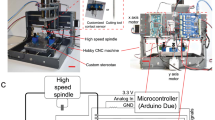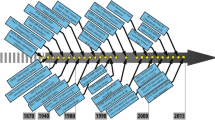Abstract
The use of robots to aid in cranial surgery derives its origins from stereotactic surgery, which was later coupled with computed tomography imaging in the 1980s. The first robotic systems were navigational and performed procedures on deep brain structures such as brain biopsies and depth electrode placement. Since that time, autonomous and semiautonomous robots have been developed that use navigation coupled with guiding either surgical manipulators or surgical tools such as drills to aid with complex open skull-base surgery. The applications currently being explored include drilling of the temporal bone for resection of vestibular schwannomas, placement of cochlear implants, and performing mastoidectomies. These procedures are otherwise time consuming and require millimetric accuracy; however, because they can be largely done with image guidance and real-time tool position information feedback, they may be partially done by a robot. This is an ideal application of Computer Assisted Design–Computer Automated Manufacturing (CAD/CAM) principles because the bone is a rigid structure that will not deform significantly of shift during surgery. In this chapter, we discuss the current prototypes of robots available for aiding in skull-base surgery.
Access this chapter
Tax calculation will be finalised at checkout
Purchases are for personal use only
Similar content being viewed by others
References
Fomenko A, Serletis D (2017) Robotic stereotaxy in cranial neurosurgery: a qualitative systematic review. Neurosurgery 83:642–650. https://doi.org/10.1093/neuros/nyx576
Hong W-C, Tsai J-C, Chang SD et al (2013) Robotic skull base surgery via supraorbital keyhole approach. Neurosurgery 72:A33–A38. https://doi.org/10.1227/NEU.0b013e318270d9de
Sutherland GR, Wolfsberger S, Lama S et al (2013) The evolution of neuroArm. Neurosurgery 72(Suppl 1):27–32. https://doi.org/10.1227/NEU.0b013e318270da19
Couldwell WT, MacDonald JD, Thomas CL et al (2017) Computer-aided design/computer-aided manufacturing skull base drill. Neurosurg Focus 42(5):E6. https://doi.org/10.3171/2017.2.focus16561
Dillon NP, Balachandran R, Siebold MA et al (2017) Cadaveric testing of robot-assisted access to the internal auditory canal for vestibular schwannoma removal. Otol Neurotol 38:441–447. https://doi.org/10.1097/MAO.0000000000001324
Lim H, Matsumoto N, Cho B et al (2016) Semi-manual mastoidectomy assisted by human-robot collaborative control - a temporal bone replica study. Auris Nasus Larynx 43:161–165. https://doi.org/10.1016/j.anl.2015.08.008
Chauvet D, Missistrano A, Hivelin M et al (2014) Transoral robotic-assisted skull base surgery to approach the sella turcica: cadaveric study. Neurosurg Rev 37:609–617. https://doi.org/10.1007/s10143-014-0553-7
Smith JA, Jivraj J, Wong R et al (2016) 30 years of neurosurgical robots: review and trends for manipulators and associated navigational systems. Ann Biomed Eng 44:836–846. https://doi.org/10.1007/s10439-015-1475-4
Gerber N, Gavaghan KA, Bell BJ et al (2013) High-accuracy patient-to-image registration for the facilitation of image-guided robotic microsurgery on the head. IEEE Trans Biomed Eng 60:960–968. https://doi.org/10.1109/TBME.2013.2241063
Dillon NP, Fichera L, Wellborn PS et al (2016) Making robots mill bone more like human surgeons: using bone density and anatomic information to mill safely and efficiently. Rep U S 2016:1837–1843. https://doi.org/10.1109/IROS.2016.7759292
Dillon NP, Fichera L, Kesler K et al (2017) Pre-operative screening and manual drilling strategies to reduce the risk of thermal injury during minimally invasive cochlear implantation surgery. Ann Biomed Eng 45:2184–2195. https://doi.org/10.1007/s10439-017-1854-0
McCulloch P, Altman DG, Campbell WB et al (2009) No surgical innovation without evaluation: the IDEAL recommendations. Lancet 374:1105–1112. https://doi.org/10.1016/S0140-6736(09)61116-8
Burger T, Laible U, Pritschow G (2001) Design and test of a safe numerical control for robotic surgery. CIRP Ann Manuf Technol 50:295–298
Author information
Authors and Affiliations
Corresponding author
Editor information
Editors and Affiliations
1 Electronic Supplementary Material
Robotic automated skull-base drilling of temporal bone in a cadaver (MP4 70,656 kb)
Rights and permissions
Copyright information
© 2021 Springer Science+Business Media, LLC, part of Springer Nature
About this protocol
Cite this protocol
Kundu, B., Couldwell, W.T. (2021). Robotic Automated Skull-Base Drilling. In: Marcus, H.J., Payne, C.J. (eds) Neurosurgical Robotics. Neuromethods, vol 162. Humana, New York, NY. https://doi.org/10.1007/978-1-0716-0993-4_10
Download citation
DOI: https://doi.org/10.1007/978-1-0716-0993-4_10
Published:
Publisher Name: Humana, New York, NY
Print ISBN: 978-1-0716-0992-7
Online ISBN: 978-1-0716-0993-4
eBook Packages: Springer Protocols




